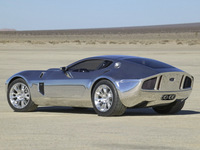Automotive Aluminum Offers Greater Weight Reduction Potential Than Steel While Retaining Strength, New Study Confirms
WASHINGTON and BRUSSELS, June 16, 2010; Using aluminum in key automotive components can safely reduce vehicle weight by as much as 40 percent, compared to only 11 percent for high-strength steel, according to a study conducted by the University of Aachen released today.
The report, conducted by the Institut fur Kraftfahrzeuge at the University of Aachen for the European Aluminium Association, analyzed 26 automotive components to assess the further potential or limits of weight reduction for both steel and aluminum. Reducing vehicle weight is key to cutting carbon emissions and improving fuel economy.
"Aluminum use in the automotive sector has increased steadily for the past four decades; however this new study makes clear the environmental and safety advantages of the high-strength, low-weight material have yet to be fully realized. This study combined with other data on the benefits of aluminum suggest a total of about 525 pounds of additional weight savings, which could result in 2.7 more miles per gallon or a nearly 10 percent further improvement in fuel economy over a typical auto today. This can be done while maintaining - if not further improving - vehicle safety," said Randall Scheps, Chairman of the Aluminum Association's Aluminum Transportation Group and Alcoa's Director of Ground Transportation.
The study found that using aluminum could result in significant weights savings for the analyzed components, ranging from 14 to 49 percent. Using a state-of-the art steel reference car, the maximum weight reduction potential of aluminum in car bodies is approximately 40 percent.
"Aluminum is more crash absorbent than steel and can safely cut vehicle weight without reducing vehicle size. This offers great potential, since lighter vehicles can produce fewer emissions and need less fuel or battery power to operate," Scheps said.
Weight reduction potential using high strength steel was limited to only an additional 11 percent. The reason the potential weight reduction using high strength steel is so small, is that nearly 40 percent of the parts analyzed simply cannot be made thinner regardless of the grade of steel used. If high strength steel were to be used to lightweight these parts, their stiffness would actually be reduced and the car's performance would suffer, whereas, aluminum could be used without reducing stiffness or causing the car's performance to suffer.
Potential for automotive aluminum lightweighting varies and options include maintaining a steel body with aluminum closures, hang-on and mounting parts, hybrid or multi-material designs for the body and full aluminum body.
"The study confirms that the lightweighting potential is still considerable. Debates in Europe usually focus on improving powertrain technologies to improve the well-to-wheel energy conversion efficiency, but this only addresses the 'supply' side of the story and ideally should be complemented by vehicle mass reduction, in order to reduce the 'demand' for energy at the wheel," added Bernard Gilmont, Transportation & Building Director for the European Aluminium Association.
Scheps concluded that "lightweighting the world's overall transportation fleet through the use of aluminum has the potential to reduce greenhouse gas emissions by nearly 660 million tons annually, or 9 percent of global, transportation-related greenhouse gas emissions."
For a copy of the study or to arrange an interview on this topic, please visit www.aluminumintransportation.org/.
About the Aluminum Association
Through its Aluminum Transportation Group (ATG), the Aluminum Association communicates the benefits of aluminum in ground transportation applications to help accelerate its penetration through research programs and related outreach activities. The ATG's mission is to serve member companies and act as a central resource for the automotive and commercial vehicle industries on aluminum issues. Members of the ATG include: Alcoa Inc., Novelis Inc., Rio Tinto Alcan, Aluminum Precision Products Inc., Kaiser Aluminum Corporation and Sapa Group.
About the European Aluminum Association
The European Aluminum Association, founded in 1981, represents the European aluminum industry from alumina and primary production to semi-finished and end-use products, through to recycling. The European aluminum industry directly employs about 236,000 people.



